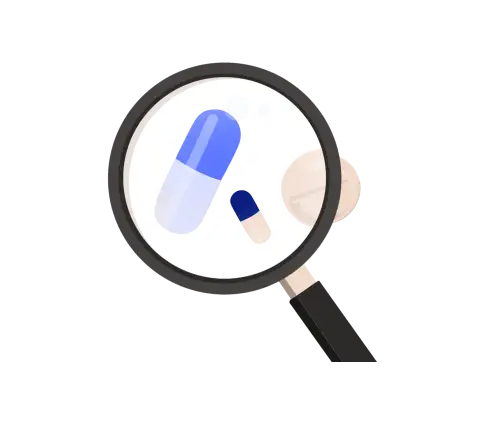
Have you found a stray pill in your medicine cabinet? Maybe a loved one mixed up their medications by mistake? There are plenty of reasons you might wonder, “What pill is this?”
HealthTopics’ Pill Identifier can help you identify an unknown medication. It identifies prescription and over-the-counter (OTC) meds taken in solid form by mouth, like tablets and capsules.
Using the Pill Identifier
Simply enter some basic details about the pill, and the Identifier provides a list of close matches or a single exact match. Each result includes a pill’s picture, brand and generic names, strength (dose), and other relevant information.
The Pill Identifier helps you identify FDA-approved medications only. It does not identify dietary supplements (e.g., most vitamins and herbals), illegal drugs, or drugs from outside the United States.
Ways to Identify a Prescription or OTC Medication
You can enter one or more of these details into the Pill Identifier:
The imprint code is the most crucial detail and is often the only information you need to narrow your search down to a single result. Since people may interpret pill colors differently, you might find it helpful to enter just the imprint code with or without the shape.
These details can also help your pharmacist identify a pill. Pharmacists might check the pill’s size and coating, and look for line-shaped markings called scores.
Understanding Imprint Codes
The numbers, letters, or other text on a pill are its “imprint code,” which helps identify it. The FDA requires most OTC and prescription drug tablets and capsules to have an imprint. This code, combined with the pill’s size, color, and shape, helps distinguish it from other medications.
A pill’s imprint code can be any single letter or number, or a combination of letters, numbers, marks, or symbols. It might include words, the drugmaker’s name, or other details. Drugmakers submit imprint codes to the FDA, which stores them in a database that healthcare professionals can access.
The FDA encourages drugmakers to include a letter or a number in a drug’s imprint code, as these digits can help healthcare workers identify a pill more easily than a symbol or logo alone. Quick pill identification can save lives during medical emergencies like accidental overdoses or drug poisonings.
However, some FDA-approved drugs are exempt from needing an imprint, due to:
Finding a Pill’s Imprint Code
You’ll find the code directly on the pill. Check both the front and back, as some drugs have imprints on both sides. If you’re using the Pill Identifier, enter the code from both sides if applicable.
Why Do Some Pills with the Same Drug Have Different Imprints?
Different imprint codes help distinguish one company’s version of a drug from another’s. Drug companies might make the same kind of medicine in varying strengths or using different inactive ingredients.
Different imprint codes can also help differentiate between higher and lower doses of a drug made by one company. Additionally, multiple generic companies might sell the same medication under different packaging, though the main ingredient and strength remain the same.
Can Several Drugs Have the Same Imprint?
Pills can have the same imprint, but each drug’s overall appearance (size, shape, color, and imprint) needs to be unique to ensure correct identification. If you can’t find a match, make sure you’re reading the imprint correctly, as characters can sometimes be misinterpreted (e.g., “Z” vs. “N,” “6” vs. “9”).
What if a Pill Has No Imprint?
A pill without an imprint might not be an FDA-approved drug. It could be:
Still, some FDA-approved drugs are exempt from the imprint code requirement.
Why Do Some Tablets Have a Line in the Middle?
Some pills have a shallow notch called a “score” that indicates where to split or cut the tablet. Only split a tablet if your pharmacist or doctor advises it. A tablet splitter or pill cutter can help ensure the correct dose.
Who Can I Call to Identify a Pill?
If you need to identify a pill, contact your pharmacist. They can look up pills by their color, shape, and imprint code and access your medication records.
For emergencies, such as an overdose or accidental poisoning, call 911 or your local poison center at 800-222-1222.
As a rule, never take unidentified pills, even if you think you’ve identified them. There’s no way to know what else they’ve come into contact with, if they’ve been tampered with, or if they’ve been stored properly. For safe disposal of prescription drugs, refer to our article on the topic.
©2024. Health Topics. All Rights Reserved.